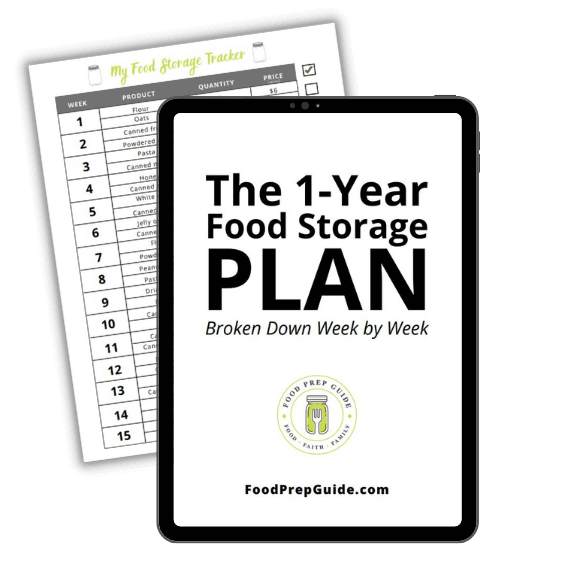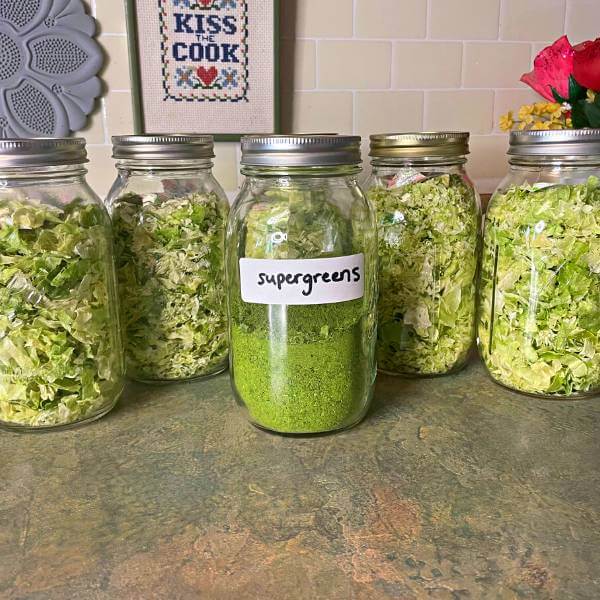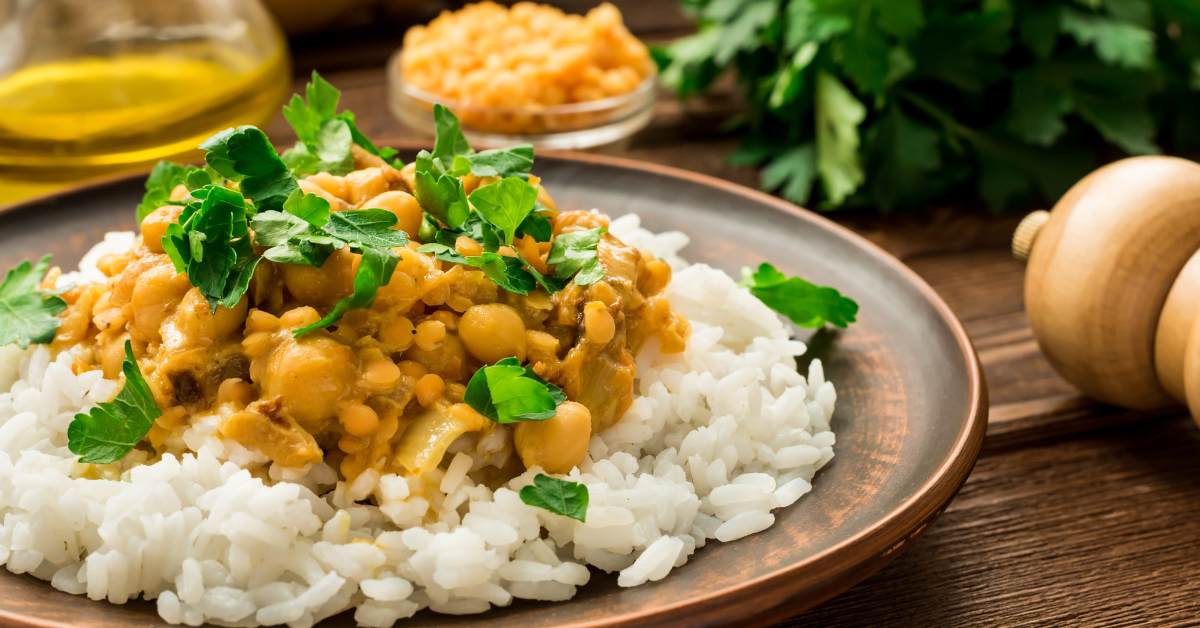Dehydrating cabbage is a simple process that allows for long-term storage and versatile usage in a variety of dishes.
With minimal preparation needed, this quick-dry project only requires a dehydrator, cutting board, and storage container.
Let’s learn how to dry cabbage so it remains nutritious, flavorful, and ready for use whenever you need it!
Why Dehydrate Cabbage?
Dehydrating cabbage ensures that you have this nutritious vegetable on hand, even during off-seasons or when fresh cabbage is not readily available.
Dried cabbage has a significantly longer shelf life, potentially lasting for years when stored properly in a cool, dark, and dry place. This frees up valuable real estate in your refrigerator or freezer!
Moreover, the dehydration process retains the flavor, color, and texture of the cabbage, making it a desirable ingredient for various dishes like soups, stews, side dishes, and stir-fries.
FREE FOOD STORAGE PLAN!

Does gathering and storing a year’s worth of food for your family seem overwhelming and unachievable?
Make it easy with our step-by-step plan. Subscribe to our weekly newsletter & we’ll send it to you FREE!
Types of Cabbage for Dehydrating
Let’s discuss a few of the most common types of cabbage for dehydrating, namely Green Cabbage, Red Cabbage, Bok Choy, and Brussels Sprouts.
Green Cabbage
Green cabbage is a popular choice for dehydrating due to its widespread availability and relatively low cost.
This type of cabbage has a mild taste and can be used in a variety of dishes, such as slaws, soups, and stews. When dehydrated, green cabbage retains its nutritional properties, including vitamins C, K, and B6 as well as manganese and fiber.
Red Cabbage
Red cabbage is another excellent option for dehydrating. With a slightly sweeter and more robust flavor than green cabbage, it can add a pop of color and taste to various recipes. Red cabbage is rich in anthocyanin—a powerful antioxidant—making it a valuable addition to your pantry.
Bok Choy
Bok Choy, also referred to as Chinese Cabbage, is a less leafy cabbage variety that’s packed with vitamins A, C, and K.
Bok Choy tends to have a mild, slightly peppery flavor that works well in stir-fries and even as a snack when dehydrated as crispy chips.
Brussels Sprouts
Brussels sprouts, while not technically a cabbage, are part of the same family of vegetables and can also be dehydrated with success.
In fact, we LOVE shredded brussels sprouts as a quick side dish. They have a unique, slightly bitter flavor that mellows out when dehydrated, making them a versatile ingredient for various recipes or a standalone side.
If you are growing cabbage for the first time, here’s how to know when cabbage is ready to harvest.
Preparations Before Dehydrating
Washing and Rinsing Cabbage
Before dehydrating, it is crucial to wash and rinse the cabbage thoroughly to remove any dirt and possible contaminants:
- Remove the outer leaves from the cabbage head, as they are more likely to hold dirt and debris.
- Place the cabbage in a colander, and gently rinse it under cold running water, massaging the leaves to loosen any dirt.
- After rinsing, let the cabbage drain or carefully pat it dry with a clean towel.
Cutting and Coring Cabbage
To prepare the cabbage for dehydrating, follow these steps:
- Using a sharp knife, carefully remove the core from the cabbage. You can do this by cutting around the stem, angling your knife towards the center of the cabbage to remove the thick core.
- Cut the remaining cabbage into quarters for easier handling.
- Finally, slice the cabbage into thin strips about 1/8″ wide, ensuring consistent size for even dehydration.
Once the cabbage has been appropriately prepared, it is ready to be placed in a dehydrator for the drying process.
Methods of Dehydrating Cabbage
There are two popular methods for dehydrating cabbage: using a food dehydrator and using an oven. Both methods are effective for drying out the cabbage, but they each come with their own unique steps and processes.
Using a Food Dehydrator
Prices pulled from the Amazon Product Advertising API on:
Product prices and availability are accurate as of the date/time indicated and are subject to change. Any price and availability information displayed on [relevant Amazon Site(s), as applicable] at the time of purchase will apply to the purchase of this product.
Dehydrating cabbage in a food dehydrator is relatively simple and tends to yield the best results. Here’s what you’ll need to do:
- Preparing the cabbage: First, wash the cabbage and then shred it into thin strips, about 1/8 to 1/4 inches wide.
- Blanching: Blanch the shredded cabbage by dipping it in boiling water for 2-3 minutes, followed by an ice bath for a few minutes to quickly cool it down. This step is optional, but it helps stop the cooking process.
- Drying: Pat the blanched cabbage dry with paper towels. Next, arrange the cabbage on the dehydrator trays in a single layer. Don’t overload the trays.
- Dehydrating: Set the dehydrator’s temperature to 125°F. The dehydration process usually takes between 8-12 hours, but it can certainly take longer. Periodically check for signs of doneness. We discuss that in-depth in the video below.
Dehydrating with an Oven
If you don’t have a dehydrator, you can still dry cabbage using your oven. The process is similar, but there are a few differences in terms of preparation and temperature control:
- Preparing the cabbage: As with the food dehydrator method, start by washing and shredding the cabbage into thin strips.
- Blanching: Optionally, blanch and cool the cabbage as described in the previous method.
- Drying: Pat the blanched cabbage dry with paper towels. Arrange the pieces on a baking sheet lined with parchment paper, maintaining a single layer and avoiding overlapping.
- Dehydrating: Preheat your oven to its lowest temperature setting (preferably around 125-135°F) and place the baking sheet on the oven’s middle rack. The dehydration process is often quicker, but it’s also easier to burn—and your oven isn’t available for regular cooking. Remember to rotate the baking sheet a few times and check on the cabbage periodically to ensure even drying.
Keep in mind that using an oven lacks the precision temperature control and air flow of an electric dehydrator, so the final results might be somewhat less consistent.
Storing Dried Cabbage
When it comes to storing dehydrated cabbage, it’s essential to keep it in an environment free from moisture and contaminants.
This can help maintain the quality and freshness of the food as well as prevent spoilage or pest infestation.
Let’s look at a few great options.
Airtight Containers and Jars
Airtight containers and mason jars are wonderful for storing dehydrated cabbage. They keep out air, moisture, and residual moisture that can lead to spoilage or mold growth.
Prices pulled from the Amazon Product Advertising API on:
Product prices and availability are accurate as of the date/time indicated and are subject to change. Any price and availability information displayed on [relevant Amazon Site(s), as applicable] at the time of purchase will apply to the purchase of this product.
To effectively store dehydrated cabbage in airtight containers or canning jars, make sure to:
- Choose the right size and type of container to fit the quantity of dehydrated cabbage. Glass jars are preferred for their durability and absence of chemicals.
- Add an oxygen absorber or vacuum seal the jar (here’s how).
- Store the jar out of direct sunlight. (Light causes color loss.)
Mylar Bags For Extra Long-Term Storage
These bags help preserve food by allowing you to remove air and maintain a low-light environment, which protects against food degradation.
Prices pulled from the Amazon Product Advertising API on:
Product prices and availability are accurate as of the date/time indicated and are subject to change. Any price and availability information displayed on [relevant Amazon Site(s), as applicable] at the time of purchase will apply to the purchase of this product.
To store dehydrated cabbage in Mylar bags, follow these steps:
- Choose the appropriate size and type of bags. You don’t want a lot of extra space in the bag.
- Fill the bag, leaving enough room to seal it.
- Add an oxygen absorber, then seal the bag with a flat iron or impulse heat sealer.
Prices pulled from the Amazon Product Advertising API on:
Product prices and availability are accurate as of the date/time indicated and are subject to change. Any price and availability information displayed on [relevant Amazon Site(s), as applicable] at the time of purchase will apply to the purchase of this product.
Remember to check your storage area periodically for signs of pests and moisture.
Using Dehydrated Cabbage in Recipes
Before incorporating dehydrated cabbage into your recipes, you’ll want to rehydrate it to achieve a desirable texture. To rehydrate dehydrated cabbage, follow these simple steps
- Measure the amount of dried cabbage you need for your recipe.
- For every cup of dehydrated cabbage, add 2 cups of water.
- Let the cabbage sit in the water for about 30 minutes or until it reaches your preferred consistency.
There are actually 3 ways to rehydrate properly, so check out our guide at that link for all the details.
As for how to use dried cabbage, here are a few of our favorites:
- Soups and Stews: Dehydrated cabbage works well in soups and stews, particularly during colder months. As long as your soup has a lot of liquid, you can actually skip the rehydration step and just toss the dried cabbage right in!
- Coleslaw: Coleslaw can be made with rehydrated cabbage, but it lacks the crisp crunch of fresh cabbage. It’s still delicious though! Combine the rehydrated cabbage with a vinegar/mayonnaise dressing, and add other ingredients like carrots and onions for a refreshing side dish.
- Fried Cabbage: We love it as a side dish fried in a skillet with some bacon grease and sliced onions.
- Unstuffed Cabbage Roll Casserole: This is a family favorite. Grab the recipe here!
Enjoy!














